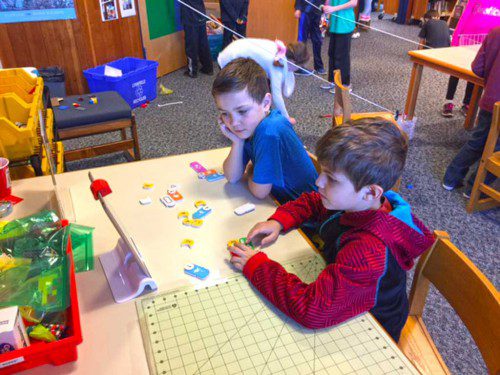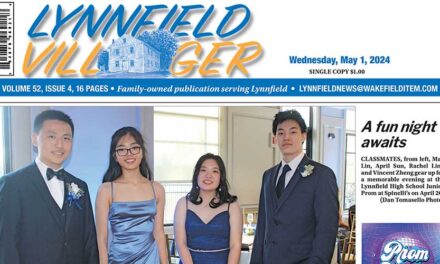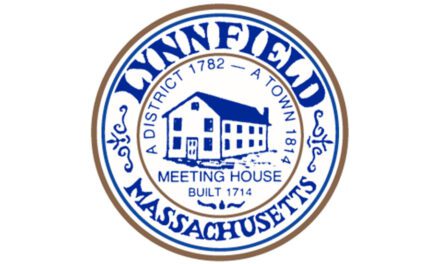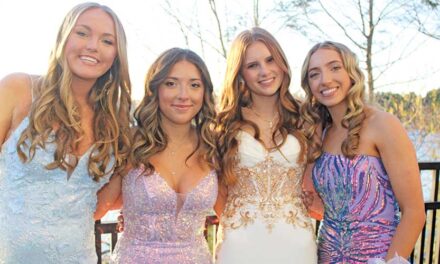Published in the March 8, 2017 edition

SECOND GRADERS Cole Mackinnon (left) and Ephram Donahue undertake a coding assignment on iPads at Huckleberry Hill School’s new maker space recently. (Courtesy Photo)
By DAN TOMASELLO
LYNNFIELD — The school system now has two new maker spaces up and running, Digital Learning Coordinator Jenn Judkins announced at last week’s School Committee meeting.
Judkins said maker spaces are “centers for creative play.” She noted the school department launched a maker space pilot program at Summer Street School and Lynnfield High School last year. The new maker spaces are located at Huckleberry Hill School and Lynnfield Middle School. Similar to the original maker spaces, the new spaces are located in each school’s media center.
The digital learning coordinator said student and parent demand led to maker spaces being established at Huckleberry Hill and LMS.
Superintendent of Schools Jane Tremblay said maker spaces are aligned to the school department’s strategic plan as school officials strive to “implement and expand alternative educational experiences that broaden student learning in nontraditional ways.”
“The most important part of our vision is creating intellectual learners who have curiosity,” said Tremblay.
Judkins said maker spaces are “student-centered rather than teacher led.”
“Students come in with an idea in their brain and try to make something happen in the real world,” said Judkins. “Our goal with the maker spaces is to provide the kids with the tools and equipment to bring these great ideas to the world.”
Judkins said maker spaces have a STEAM (science, technology, engineering, art and math) focus. She said maker spaces are connected to other academic areas as well.
Additionally, Judkins said students and teachers at Huckleberry Hill and LMS participated in an orientation program before the maker spaces opened for learning.
Huckleberry Hill
Huckleberry Hill media specialist Sue Owens said the elementary school launched its maker space in October. She said the maker space’s stations include coding, electronics, recycled crafts, and construction and Lego areas.
Owens said third graders recently created “weather stations out of different materials” at the maker space.
“The kids loved it,” said Owens. “The ideas they came up with were incredible. The teachers enjoyed it as well.”
Owens said the maker space includes zip lines, which has helped students learn about force and motion. She said kindergarteners and third graders undertook a joint project in December that involved making a gingerbread man trap.
According to Owens, students have learned to build things out of different shapes at the maker space. She said first graders used the Scratch Jr. coding app while undertaking a recent project on sun patterns. She said fourth graders used the maker space for a recent project on electric circuits.
Owens said students are enjoying the maker space immensely.
“It’s been great,” said Owens. “I was a little nervous and scared at first, but I think it’s an A+.”
Owens said students usually work in pairs or small groups at the maker space.
“I think it has worked out very well,” said Owens. “It’s educating and entertaining students.”
Owens said the maker space program has made a positive impact on special education students because it helps students learn in unique ways.
Additionally, Owens said both parents and teachers “are on board” with the maker space initiative as well.
“Teachers have come to me and said they would like to get the kids to do a hands-on project with the maker space,” said Owens.
LMS
Judkins said the middle school launched its maker space in January. She said the first project middle school students undertook was making a short stop-motion animation video, which took place after orientation.
“Students were able to unleash their creativity,” said Judkins.
Judkins said the middle school’s maker space includes video production and recycled crafts stations. She said an Ozobot Robot station was introduced last week, which she said will “kick off our robotics area.”
The digital learning coordinator said the middle school has asked a group of students to become maker space ambassadors.
“They are our pioneers,” said Judkins. “They are learning some new things and are sharing that with their peers. They are also helping manage the space.”
Judkins said the maker space has been used for different projects. She said sixth and seventh graders made a video with a Green Screen for an English project.
“It was amazing to see how theatrical they got with costumes,” said Judkins. “Students were reenacting a scene from a book they have read, and were able to select a background that was representative of that book. It was really neat to see how creative they were.”
Judkins said seventh grade students created a stop-motion video on deriving the area of a circle for a math project.
“All of the kids’ creations were different,” said Judkins.
Innovative leader
Since launching the maker space program last year, Judkins has discussed and showed off the program to school officials and teachers from surrounding districts.
“Maker spaces are really becoming a hot topic in education, particularly in Massachusetts,” said Judkins. “We are really fortunate that we adopted this early, and many districts have been coming to see our spaces. We have had over a dozen schools visit us at this point and many more have signed up.”
Additionally, Judkins and Tremblay gave a presentation on the school system’s maker spaces at the Massachusetts Association of School Committees (MASC) and Massachusetts Association of School Superintendents (MASS) Conference recently. Owens, Summer Street media specialist Alex Caram and LHS media specialist Janice Alpert gave a presentation at the Massachusetts School Library Association (MSLA) Conference as well.
SC reaction
School Committee member Rich Sjoberg said his second grader loves the maker space at Huckleberry Hill.
“On the days he uses the maker space, I don’t get the usual ‘school was fine, recess was great’ answer when I ask how his day was,” said Sjoberg.
School Committee member Jamie Hayman agreed with Sjoberg kids love using the maker space. He asked if there are any barriers such as time that would prevent maker spaces from being expanded.
Owens said she believes teachers can work around the time concern, as students can use the maker space before or after school. She said students are allowed to use the maker space during recess as well.
“You have to be open that it is okay to have everybody in there,” said Owens.
Judkins said there are costs needed to run a maker space.
“We are very purposeful about the activities we pick so we are not choosing things that are costly, but there are expenses whether it’s a buying ribbons for a printer, paper or a bunch of Popsicle sticks,” said Judkins. “These are not expensive things, but there is no budget for them. To date, we have used donations, grants and the (school) library budget. I have talked to Jane about this so we are aware about it going forward. We want these spaces to be current and exciting.”




